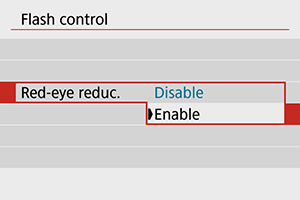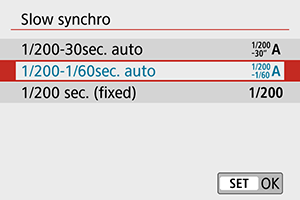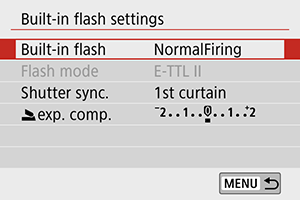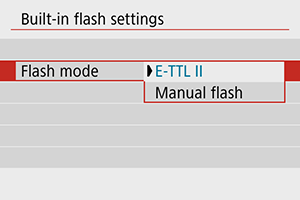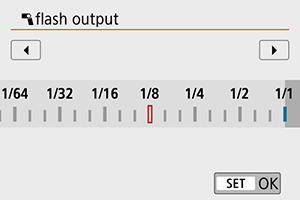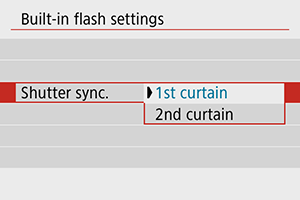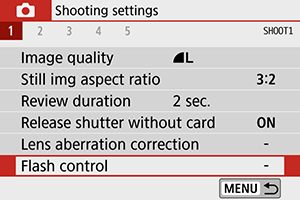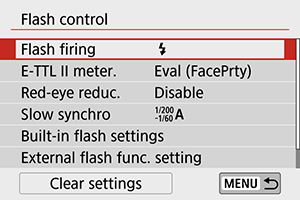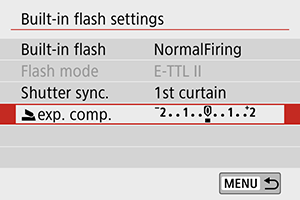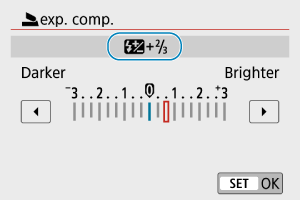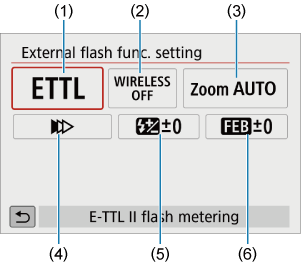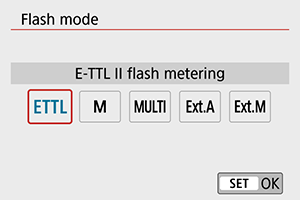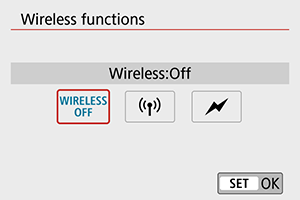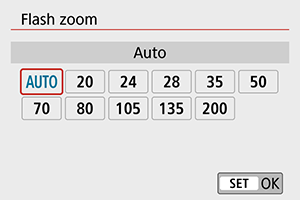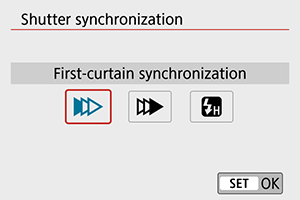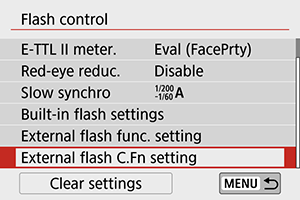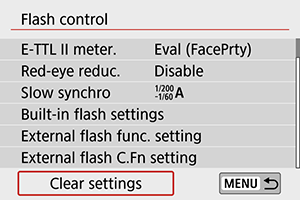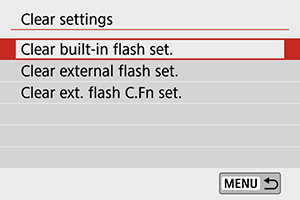|
|
EOS REBEL T8i: Flash Function Settings
| Article ID: ART176913 |
| |
Date published: 06/19/2020 |
| |
Date last updated: 09/14/2023 |
Description
Flash Function Settings
Solution
|
Flash Function Settings
Functions of the built-in flash or external EL/EX series Speedlites can be set from menu screens on the camera.
Before setting functions of external Speedlites, attach the Speedlite and turn it on.
For details on external Speedlite functions, refer to the Speedlite's instruction manual.
-
Select [ : Flash control]. : Flash control].
-
Select an option.
Flash Firing
-
Set to [ ] (in Basic Zone or ] (in Basic Zone or  modes) to have the flash fire automatically, based on shooting conditions. modes) to have the flash fire automatically, based on shooting conditions.
-
Set to [ ] to have the flash always fire when you shoot. ] to have the flash always fire when you shoot.
-
Select [ ] (in Creative Zone modes) to keep the flash off, or if you will use the AF-assist beam. ] (in Creative Zone modes) to keep the flash off, or if you will use the AF-assist beam.
E-TTL II Metering
-
Set to [Eval (FacePrty)] for flash metering suitable for shots of people. Continuous shooting speed for [ ] will become slower than when [Evaluative] or [Average] is selected. ] will become slower than when [Evaluative] or [Average] is selected.
-
Set to [Evaluative] for flash metering that emphasizes firing in continuous shooting.
-
If [Average] is set, the flash exposure will be averaged for the entire metered scene.
Caution
- Even with the camera set to [Eval (FacePrty)], results may not be as expected, depending on the shooting conditions and subject.
Red-Eye Reduction
Set to [Enable] to reduce red-eye by firing the red-eye reduction lamp before firing the flash.
Slow Synchro
You can set the flash-sync speed for flash photography in  mode or mode or  mode. mode.
-
[ ] 1/200-30sec. auto ] 1/200-30sec. auto
The flash sync speed is set automatically within a range of 1/200 sec. to 30 sec. to suit the scene's brightness. Slow-sync shooting is used in low-light locations (under some shooting conditions), and shutter speed is automatically lowered.
-
[ ] 1/200-1/60sec. auto ] 1/200-1/60sec. auto
Prevents a slow shutter speed from being set automatically in low-light conditions. It is effective for preventing subject blur and camera shake. However, while the subject will be properly exposed with the flash, the background may come out dark.
-
[ ] 1/200 sec. (fixed) ] 1/200 sec. (fixed)
The shutter speed is fixed at 1/200 sec, which is more effective in preventing subject blur and camera shake than with [1/200-1/60sec. auto]. However, in low light, the subject's background will come out darker than with [1/200-1/60sec. auto].
Caution
- To use slow-sync shooting in
 or or  mode, set to [1/200-30sec. auto]. mode, set to [1/200-30sec. auto].
Built-in Flash Settings
Flash mode
Set to [E-TTL II] to shoot in E-TTL II/E-TTL fully automatic flash mode. To enable [Flash mode], select [CustWireless] in [Built-in flash].
Set to [Manual flash] to specify your preferred flash output manually.
Shutter sync.
Normally, set this to [1st curtain] so that the flash fires immediately after the shooting starts.
Set to [2nd curtain] and use low shutter speeds for natural-looking shots of subject motion trails, such as car headlights.
Caution
- When shooting with [2nd curtain], set a slow shutter speed of 1/80 sec. or slower. If the shutter speed exceeds 1/80 sec., first-curtain synchronization is used automatically even if [2nd curtain] is set.
 exp. comp. exp. comp.
Set the flash exposure compensation if the brightness of the subject does not come out as desired (so you want to adjust the flash output) in flash photography. You can set the flash exposure compensation up to ±2 stops in 1/3-stop increments.
-
Select [ exp. comp.]. exp. comp.].
-
Set the compensation amount.
- If the exposure is too dark, press the
 key (for increased exposure). key (for increased exposure).
- If the exposure is too bright, press the
 key (for decreased exposure). key (for decreased exposure).
- When you press the shutter button halfway, the
 icon will appear in the viewfinder. icon will appear in the viewfinder.
- After taking the picture, cancel the flash exposure compensation by setting it back to 0.
Caution
- If [
 : Auto Lighting Optimizer] () is set to any setting other than [Disable], the image may still look bright even if a decreased flash exposure compensation is set. : Auto Lighting Optimizer] () is set to any setting other than [Disable], the image may still look bright even if a decreased flash exposure compensation is set.
- If flash exposure compensation is set with a Speedlite (sold separately, ), you cannot set the flash exposure compensation with the camera (Quick Control or External flash func. setting). Note that the Speedlite's setting overrides the camera's if both are set at the same time.
Note
- The exposure compensation amount will remain in effect even after you set the power switch to
 . .
Wireless func.
See Wireless Flash Photography Using Optical Transmission if you will use the sender function of the built-in flash in optical wireless shooting. Refer to the instruction manual of the external flash unit if you will use the sender function of the external flash in radio or optical wireless shooting.
External Flash Function Settings
The information displayed, position of display, and available options vary depending on the Speedlite model, its Custom Function settings, the flash mode, and other factors. Refer to the instruction manual of your flash unit for details on its functions.
Sample display
- (1)Flash mode
- (2)Wireless func./Firing ratio control
- (3)Flash zoom (flash coverage)
- (4)Shutter synchronization
- (5)Flash exposure compensation
- (6)Flash exposure bracketing
Caution
- Functions are limited when using EX series Speedlites that are not compatible with flash function settings.
Flash mode
You can select the flash mode to suit your desired flash photography.
- [E-TTL II] is the standard mode of EL/EX-series Speedlites that support autoexposure flash photography.
- [Manual flash] is for setting the Speedlite's [Flash output] yourself.
- [CSP] (Continuous shooting priority mode) is available when using a compatible Speedlite. This mode automatically reduces flash output by one stop and increases ISO speed by one stop. Useful in continuous shooting, and helps conserve flash battery power.
- Regarding other flash modes, refer to the Instruction Manual of a Speedlite compatible with the respective flash mode.
Caution
- Adjust Exposure Compensation as needed in case of overexposure from flash photography with [CSP] in
 or or  mode. mode.
Note
- With [CSP], ISO speed is automatically set to [Auto].
Wireless functions
You can use radio or optical wireless transmission to shoot with wireless multiple-flash lighting.
For details on wireless flash, refer to the Instruction Manual of a Speedlite compatible with wireless flash photography.
Firing ratio control
With a macro flash, you can set the firing ratio control.
For details on firing ratio control, refer to the macro flash's Instruction Manual.
Flash zoom (flash coverage)
With Speedlites equipped with a zooming flash head, you can set the flash coverage.
Shutter synchronization
Normally, set this to [First-curtain synchronization] so that the flash fires immediately after the shooting starts. Set to [Second-curtain synchronization] and use low shutter speeds for natural-looking shots of subject motion trails, such as car headlights.
Set to [High-speed synchronization] for flash photography at higher shutter speeds than the maximum flash sync shutter speed. This is effective when shooting with an open aperture in  mode to blur the background behind subjects outdoors in daylight, for example. mode to blur the background behind subjects outdoors in daylight, for example.
Caution
- When using second-curtain synchronization, set the shutter speed to 1/80 sec. or slower. If the shutter speed exceeds 1/80 sec., first-curtain synchronization is used automatically even if [Second-curtain synchronization] is set.
Flash exposure compensation
Just as exposure compensation is adjustable, you can also adjust flash output of external Speedlites.
Caution
- If flash exposure compensation is set with the Speedlite, you cannot set the flash exposure compensation with the camera. Note that the Speedlite's setting overrides the camera's if both are set at the same time.
Flash exposure bracketing
External Speedlites equipped with flash exposure bracketing (FEB) can change the external flash output automatically as three shots are taken at once.
External Flash Custom Function Settings
For details on the external Speedlite's Custom Functions, refer to the Speedlite's Instruction Manual.
Caution
- With an EL/EX series Speedlite, the Speedlite will always fire at full output if the [Flash metering mode] Custom Function is set to [1:TTL] (autoflash).
- The external Speedlite's Personal Function (P.Fn) cannot be set or canceled from the camera's [
 : External flash func. setting] screen. Set it directly on the external Speedlite. : External flash func. setting] screen. Set it directly on the external Speedlite.
Clear Flash Settings/Clear All Speedlite Custom Functions
-
Select [Clear settings].
-
Select the settings to be cleared.
-
Select [Clear built-in flash set.], [Clear external flash set.], or [Clear ext. flash C.Fn set.].
-
On the confirmation screen, select [OK] to clear all flash settings or Custom Function settings.
|
|


